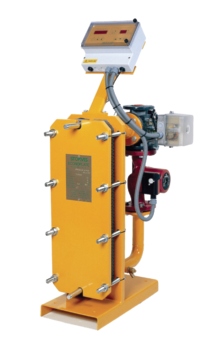Plate heat exchangers meet hot-water services

Paul Sands of Stokvis Energy Systems explores the many benefits of plate heat exchangers for delivering domestic hot water and how to get the best from them.
The traditional way of providing domestic hot water was to utilise a boiler to heat the water via a coil in a storage tank (a calorifier) and to store it until it is required. It’s a system that has worked satisfactorily for generations, but today — with more emphasis on energy efficiency, cost and health and safety — this system increasingly fails to meet expectations.
While still widely used, hot-water-storage systems suffer one unavoidable disadvantage — they are designed to hold hot water at a certain temperature over an extended period.
Domestic systems, producing hot water for a single household, are generally small affairs with storage tanks holding only a couple of hundred litres. Commercial calorifiers are huge by comparison, with capacities of 3000 l or more.
Modern insulation methods can reduce heat-loss from calorifiers very effectively, but heat-loss is still unavoidable — and lost heat means lost energy, which is both wasteful and costly.
Another problem is that calorifiers are not good at regulating temperature. A large body of hot water naturally develops a temperature gradient, with cooler water at the bottom and hotter water at the top. They sometimes rely on constant water movement by a circulation pump to prevent stagnation and cold-spots developing in the system.
For many years, there was no practical alternative to the established heating and storing of water but the development of modern plate heat exchangers (PHEs) has changed all that.
A hot-water system using a plate heat exchanger does not store hot water. The water is heated instantaneously and only when required. In the domestic context, this is seen in the guise of combi-boilers which fire up when you turn on the tap, while additionally heating water for space heating
A PHE consists of a pack of plates (usually stainless steel) to transfer heat from the primary fluid to the secondary fluid. The plates and gaskets are arranged to form alternating channels between the primary and secondary fluids, giving an extremely large heat-transfer surface area, so considerably high loads are achieved from a very compact plate heat exchanger.
Even a commercial plate heat exchanger capable of supplying a large hotel or apartment block typically measures little more than 1 m high and 500 mm wide.
Having made the argument for the instantaneous generation of hot water, it is sometimes necessary to have a small buffer vessel working with a plate heat exchanger, but this is generally only required if the boiler load is not available To avoid the need for a buffer vessel one should consider if certain LTHW systems can be overridden to provide priority for hot-water services.

For large commercial applications a PHE is well suited as it is capable of producing hot water instantly and constantly at peak times. Calorifiers and direct-fired water heaters are less reliable and can run out of hot water if demand is higher than normal.
Plate heat exchangers are also easy to maintain. An engineer can usually strip, clean and re-assemble a typical unit within an hour, and they are easy to keep clean.
There is no need for annual insurance inspections, with the disruption and downtime that results. Insurers usually require that hot-water-storage systems are opened and inspected at least once a year — unnecessary with a PHE.
Because they do not store hot water, PHEs present a far lower risk of contamination of the water with legionella. The water is heated instantly on demand, so the bacteria, which thrive in wet environments at temperatures between about 20 and 50°C, have no chance to multiply.
The output of a PHE can be tailored to the exact requirements of the system simply by varying the number of plates in the unit. Upgrades are easily achieved by adding more plates.
Even the problems posed by hard water are minimised with a plate heat exchanger. Less-prolonged contact with the boiler water, even heat distribution and the high velocity of water through the PHE makes the accumulation of limescale less likely than in a conventional calorifier.
There are compelling economic reasons for choosing PHEs over traditional calorifiers — but convenience and health are also main attractions. It is always difficult to identify the exact savings that will be made by replacing a storage calorifier or direct gas-fired water heater as every installation is different. But what is not in doubt is that savings will be made.
Paul Sands is sales and marketing director Stokvis Energy Systems.







